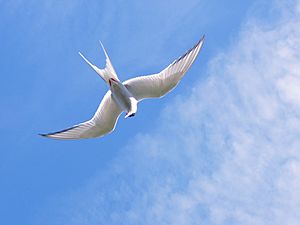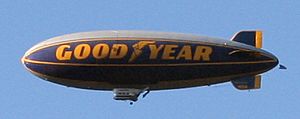Flight facts for kids
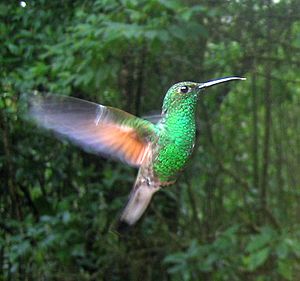
Flight is when something moves through the air or even space without touching the ground or another surface. This can happen with power, like a jet engine pushing an airplane, or without power, like a thrown ball.
Many animals are amazing at flying! Birds, insects, and bats are great at controlled flight. Long ago, Pterosaurs, which were flying reptiles, also soared through the skies. All these animals use their wings to create lift and fly. Some animals, like flying squirrels or certain fish, can glide or parachute through the air. The fastest flying animal is the peregrine falcon, which can dive at over 370 kilometres per hour (230 miles per hour)!
Contents
How do things fly?
Floating in the air
Some things fly by being lighter than air. This is called buoyant flight. Imagine a giant balloon filled with a very light gas, like helium. Because the gas inside is lighter than the air outside, the balloon floats up!
An aerostat is a type of aircraft that uses this idea. Airships and balloons are aerostats. They have a big envelope (a kind of skin) filled with a special gas that makes them float. They don't need to move fast to stay in the air.
Flying with wings
Powered vs. unpowered flight
Not everything that flies uses an engine or strong muscles to push itself forward. For example, a flying squirrel doesn't have an engine; it just glides from tree to tree. This is called gliding.
Some birds, like raptors, and human-made sailplanes can use rising air currents to gain height. This is called soaring. However, most birds and all powered aircraft need power to climb and move forward. This is known as powered flight.
Animal flight
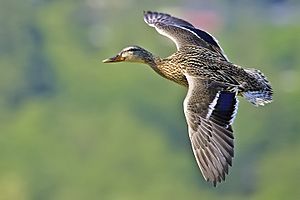
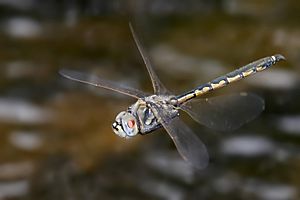
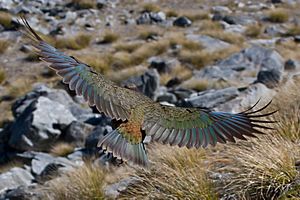
Only a few groups of living animals can truly fly with power: birds, insects, and bats. Many other animals can glide. Long-extinct Pterosaurs were also powerful flyers. Each of these groups developed their wings in different ways over millions of years.
Bats are the only mammals that can fly. However, there are several gliding mammals that use skin flaps between their limbs to glide. Some can travel hundreds of meters! Flying frogs use their large webbed feet to glide, and some flying lizards use their ribs to create gliding surfaces. Even ""Flying" snakes" can flatten their bodies to glide through the air.
Flying fish can glide using their large, wing-like fins. They can soar for hundreds of meters to escape predators underwater. The longest recorded flight of a flying fish was 45 seconds!
Most birds can fly, but there are some exceptions. Large birds like the ostrich and emu cannot fly. Penguins also can't fly, but their wings are perfect for swimming underwater. Many small flightless birds live on islands where flying isn't as necessary for survival.
Among living flying animals, the wandering albatross has the largest wingspan, reaching up to 3.5 meters (11 feet). The great bustard is the heaviest flying bird, weighing up to 21 kilograms (46 pounds).
Most insects can fly when they are adults. They use different ways to create lift with their tiny wings.
Machines that fly
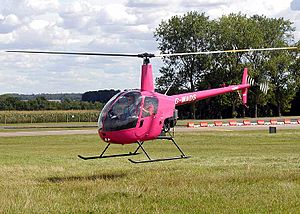
Mechanical flight is when humans use machines to fly. These machines include airplanes, gliders, helicopters, airships, and even spacecraft. Gliders can fly without an engine, just by using air currents.
In an airplane, the wings are specially shaped to create lift as air flows over them. These wings are often called airfoils. There are different wing shapes, each designed for a specific type of flight.
Faster than sound
Supersonic flight means flying faster than the speed of sound. When an aircraft breaks the sound barrier, it creates a loud "sonic boom" that can be heard on the ground. Flying this fast requires a lot of energy.
Very fast flight
Hypersonic flight is even faster than supersonic flight. At these extreme speeds, the air around the aircraft gets so hot that it can cause chemical changes in the air. Space Shuttles and Soyuz spacecraft achieve hypersonic speeds when they re-enter Earth's atmosphere.
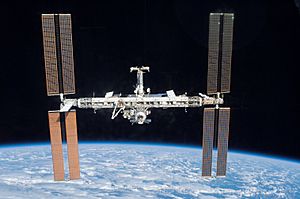
Ballistic flight
Flight through air
Some objects fly mostly because of their initial push, gravity, and air resistance, with little to no lift. This is called ballistic flight. Think of a thrown ball, an arrow, or a bullet. They follow a curved path through the air.
Flight in space
Spaceflight is like an extreme form of ballistic flight. It's about using space technology to send spacecraft into and through outer space. This includes things like ballistic missiles and orbital spaceflight.
Spaceflight is used for exploring space, but also for things like space tourism and sending up satellites for TV and internet. Other uses include space observatories and earth observation satellites that watch our planet.
A spaceflight usually starts with a rocket launch. The rocket provides the powerful push needed to escape Earth's gravity. Once in space, the spacecraft's movement is studied in a field called astrodynamics. Some spacecraft stay in space forever, some burn up when they return to Earth, and others land on planets or moons.
Images for kids
-
Human-invented flight: a Royal Jordanian Airlines Boeing 787
-
Lighter-than-air airships are able to fly without any major input of energy
See also
 In Spanish: Vuelo para niños
In Spanish: Vuelo para niños


